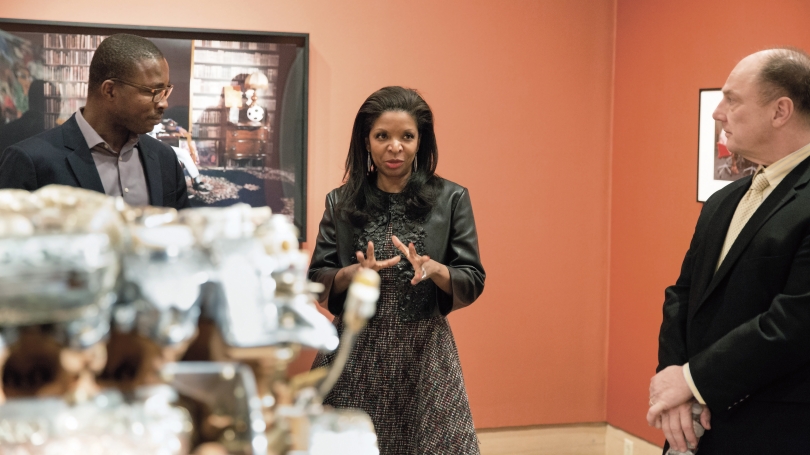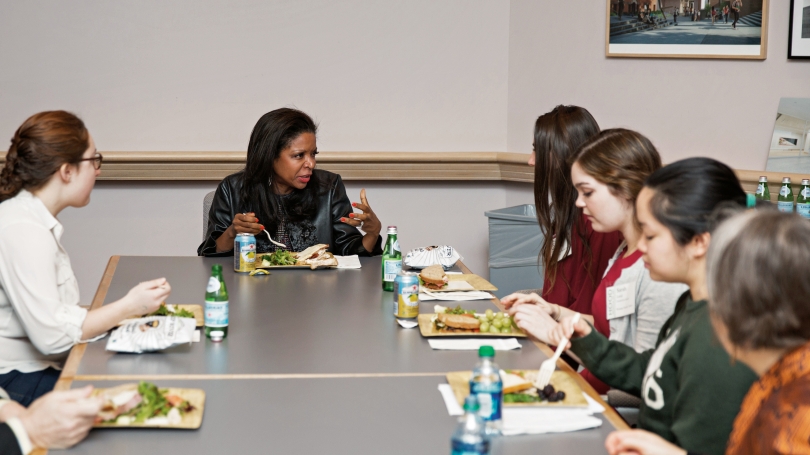Hood Quarterly, spring/summer 2016
John Stomberg, Virginia Rice Kelsey 1961s Director, and Pamela Joyner ’79
The inimitable Pamela Joyner ’79 recently spent a day at the Hood discussing our plans for the future of the museum. Joyner, trustee emerita and representative to the combined Hood Museum of Art / Hopkins Center Board of Overseers, currently sits on the boards of the Art Institute of Chicago and the Tate Americas Foundation, the Tate Modern’s International Council and North American Acquisitions Committee, the Modern and Contemporary Art Visiting Committee at the Art and Practice Foundation started by the artist Mark Bradford, and the President’s Committee on the Arts and Humanities. She recently semi-retired from a career in finance to pursue her passion for art-collecting full time. In particular, she is determined to expand the canon of twentieth-century and contemporary art to become one that is more inclusive of artists of African descent. She sat down with Virginia Rice Kelsey 1961s Director John Stomberg and an audience of Hood senior interns to record this interview.
JS: How would you describe your mission in the arts now, and at what point did your interest in art transform to the deeper quest to reconceive the canon and really look at underrepresented artists?
PJ: Like a lot of people, we had empty walls and we had to fill them, but then I was fortunate enough to meet a number of artists and curators early in my journey. We started just circumstantially to collect artists who were immersed in the tradition of abstraction. They were African American artists and many were completely overlooked by the art-historical canon. These were mostly men working with no reinforcement from the art world and virtually no reinforcement from the African American community. When they started their careers, in the fifties or earlier, the mainstream art world gave credence to work that contained identifiably black subject matter. Similarly, the African American community, based on what was happening in the environment at the time, wanted to see uplifting images of African Americans. And here were these guys who said, “No, we’re universalists and we’re going to paint what it is we want to paint.” I think the show Witness: Art and Civil Rights in the Sixties relates to my point. We own works by about 70 percent of the artists in that show. Bill Williams, Sam Gilliam, and Norman Lewis all started at that earlier point. Now there are different generations of artists, but we started our quest there.
I was so drawn to those stories. We started collecting those earlier artists deeply. Then I asked myself, if you spent a lifetime doing philanthropy, can you make a difference and how do you make a difference? We decided that this mission was something we could pursue and see to its fruition. We are thrilled that we are getting a fair amount of results around that mission.
JS: You are making a difference, especially in the lives of artists. There is no doubt about that. Now, one of the things that you support here at the Hood is the Space for Dialogue program, where students get to curate. And you also support artists through your collecting and residencies. What are the next steps in your collecting and art philanthropy?
PJ: We think about what artists have to have to be successful. This is a three-pronged process. First, they have to have the curatorial/critical support. We have thought about that in the context of our collection and our philanthropy. This is what led to the process of us doing the book that, after three years of work, we are about to send to press. We have included over twenty scholars from major institutions around the world. They’ve written on various artists or various movements from within our collection. So, the book features the critical and scholarly support.
Second, you have to have the collectors, and you have to have museum participation in the process of collecting these artists. That actually is the major focus of our philanthropy now. We are working hard to get pictures on the wall. Exhibitions are the backdrop of that, but our view is that exhibitions are usually three- to six-month phenomena and not permanent. What you put in a museum collection is a more permanent thing.
And, finally, you have to have the distribution channel for these artists. Gallerists have to come to their own conclusions about whom they represent and about being stewards of the various artists’careers that they represented. As collectors, we try to be good stewards of the careers of the artists we collect. We make sure we show these artists in our home and in our residency—and we make sure they are out in the world so that the distribution channels are aware of who is collecting their work.
JS: I am very impressed.This is such a serious enterprise and you have just imagined it into being. You are also involved with several major museums. The Hood is smaller and geared toward students. Do you have advice for students on how best to use the Hood?
PJ: Aggressively. I mean, I think there is a lot here. I’ve heard so many different ways from the students here, just sitting around this table today. Access to the organization is key. You have to find your access point, right? It was the hallmark of my Dartmouth experience. I did some things that weren’t standard. I made up my own thing, created my own path, and there is no better place to do that than in a museum that has at least 65,000 objects. The possibilities are unlimited and I think that’s really important. Right now you can walk five minutes to that kind of resource; at no other time in your life will you be able to do that.
JS: You have a lot of experience with museums in general. You are a Dartmouth grad. And you have experience with the Hop/Hood Board. We are about to close during renovation and then we will reopen and reinvent ourselves once again. Is there anything you’d like to say to us as we move forward? Is there something you hope we will do when we reopen?
PJ: I think I hear you doing it. It’s always good, especially when you reach these points of reflection, to rethink your mission. And you may decide that what you’ve always done is what you want to do on an ongoing basis. But you can reexamine your history in a more robust way, and you may decide that you want to take a different approach. I mean, I hear what you’re saying and a different approach always is exciting. But you know for those of us who are business-type people, I think it’s important to overlay that with an element of real pragmatism. I do this in the way I interface with museums. I ask myself in a high level of detail: Where can I make a singular difference? What can I do that nobody else can do? And, do I have the brains, the bucks, and the time to do it? And sometimes the answer to these question is yes and sometimes the answer is no.
JS: What advice do you have for young people who want to start collecting art?
PJ: I think anyone can start collecting art at any time.You do not need a tremendous amount of resources to do that. I think, however, the first collection you have to start to put together is a book collection. Your good Dartmouth training will tell you that. You’ve got to go do research first. You [referring to the students in the room] are all much more expert than I will ever be at the new kinds of research processes. Then, prints are a great start. Art done by younger artists is also a good place to begin. Go to MFA shows and discover artists whom no one has ever heard of and buy what you like.
For us, it’s actually been really fun and interesting to put a narrative around what we do. It keeps us focused. That doesn’t mean you can’t step outside of that narrative, but it puts a framework around the way you do your homework and the way you craft your collection. Now, for instance, we’re probably going to get to the point where we begin to deaccession the very early part of our story. It is not because it’s not a great story. It’s because I think we’ve told that story now and I want to move on to some other things. I don’t necessarily want to be bogged down in the first part of the story.
We also think of ourselves as real stewards. These objects will belong to us only for a short time. Then, some of them will go to our heirs and some will go to the institutions we support. I’ve never sold a painting and don’t really ever intend to sell a painting. It’s not impossible that circumstances would put us in that situation, but I just don’t like to sell art. We have deaccessioned work by means of trade, where we trade certain things for certain other things.
So, I think that starting from this day, or from the day you graduate, you could put together a collection that you’ll look back on in twenty, thirty, forty years and say, “This has been part of my life’s work—this is the story that I’ve been telling.” And there’s a difference that highlighting that story will make in the cultural life of your community, your country, and your world.

